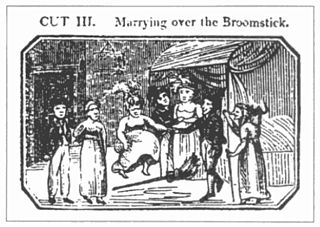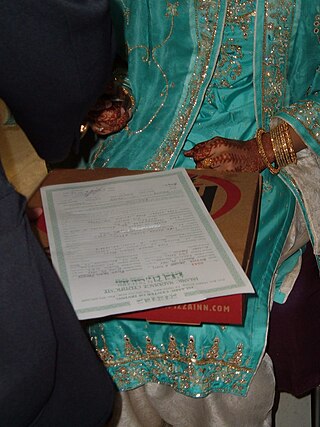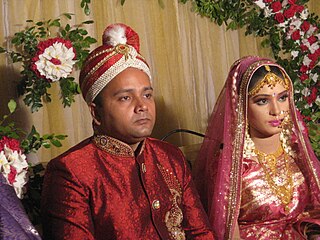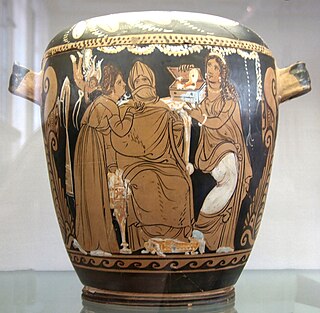
Handfasting is a traditional practice that, depending on the term's usage, may define an unofficiated wedding, a betrothal, or a temporary wedding. The phrase refers to the making fast of a pledge by the shaking or joining of hands.

Jumping the broom is a phrase and custom relating to a wedding ceremony in which the couple jumps over a broom. It is most widespread among African Americans and Black Canadians, popularized during the 1970s by the novel and miniseries Roots, and originated in mid-19th-century antebellum slavery in the United States. The custom is also attested in Irish weddings.

A wedding is a ceremony where two people are united in marriage. Wedding traditions and customs vary greatly between cultures, ethnic groups, races, religions, denominations, countries, and social classes. Most wedding ceremonies involve an exchange of marriage vows by a couple, presentation of a gift, and a public proclamation of marriage by an authority figure or celebrant. Special wedding garments are often worn, and the ceremony is sometimes followed by a wedding reception. Music, poetry, prayers, or readings from religious texts or literature are also commonly incorporated into the ceremony, as well as superstitious customs.

An engagement or betrothal is the period of time between the declaration of acceptance of a marriage proposal and the marriage itself. During this period, a couple is said to be fiancés, betrothed,intended, affianced, engaged to be married, or simply engaged. Future brides and grooms may be called fiancée (feminine) or fiancé (masculine), the betrothed, a wife-to-be or husband-to-be, respectively. The duration of the courtship varies vastly, and is largely dependent on cultural norms or upon the agreement of the parties involved.

In many traditions and statutes of civil or religious law, the consummation of a marriage, often called simply consummation, is the first act of sexual intercourse between two people, following their marriage to each other. The definition of consummation usually refers to penile-vaginal sexual penetration, but some religious doctrines hold that there is an additional requirement that no contraception must be used.
A Hindu wedding, also known as Vivaha, Marathi: Lagna (लग्न), Bengali: Bibaho (বিবাহ) Kalyanam or Pelli, is the traditional wedding ceremony for Hindus. The wedding ceremonies are very colourful, and celebrations may extend for several days. The bride's and groom's home—entrance, doors, wall, floor, roof—are sometimes decorated with colors, flowers, and other decorations.

An Islamic marriage contract is considered an integral part of an Islamic marriage, and outlines the rights and responsibilities of the groom and bride or other parties involved in marriage proceedings under Sharia. Whether it is considered a formal, binding contract depends on the jurisdiction. Islamic faith marriage contracts are not valid in English law, nor American Law. Because of this, some Islamic Marriage Officiants will only officiate a marriage after the couple had been legally married in court.
Nishekam is the ritual associated with first sexual intercourse among Hindus. Consummation is allowed only on the night of the 4th day after Vivaham (marriage).

Traditional Russian weddings can last between two days and one week. The celebration usually involves dancing, singing, toasting, and banqueting. The best man and bridesmaid are called "Witnesses" or "Свидетели" in Russian. The ceremony and the ring exchange take place on the first day of the wedding. Russian weddings ceremonies have undertaken a certain amount of Western traditions, including incorporating maids of honour into the wedding party.

Marriage in Cambodia is a social institution which structures Khmer society. The Khmer wedding, with its long history and rich symbolism, is also famous for its specific music, known as phleng kar.
In the United States and Canada, weddings follow traditions often based on religion, culture, and social norms. Most wedding traditions in the United States and Canada were assimilated from other, generally European, countries. Marriages in the U.S. and Canada are typically arranged by the participants and ceremonies may either be religious or civil. There is a tradition that the prospective bridegroom ask his future father-in-law for his blessing.

Erusin is the Hebrew term for betrothal. In modern Hebrew, "erusin" means engagement, but this is not the historical meaning of the term, which is the first part of marriage.

Traditional marriage customs in the Philippines and Filipino wedding practices pertain to the characteristics of marriage and wedding traditions established and adhered by them Filipino men and women in the Philippines after a period of adoption courtship and engagement. These traditions extend to other countries around the world where Filipino communities exist. Kasalan is the Filipino word for "wedding", while its root word – kasal – means "marriage". The present-day character of marriages and weddings in the Philippines were primarily influenced by the permutation of Christian, both Catholic and Protestant, Hindu, Islam, Chinese, Spanish, and American models.

Muslim marriage and Islamic wedding customs are traditions and practices that relate to wedding ceremonies and marriage rituals prevailing within the Muslim world. Although Islamic marriage customs and relations vary depending on country of origin and government regulations, both Muslim men and women from around the world are guided by Islamic laws and practices specified in the Quran. Islamic marital jurisprudence allows Muslim men to be married to multiple women.
The Telugu Hindu wedding ceremony is the traditional wedding ceremony of the Telugu people in India. In the 19th century, the ceremony could last up to sixteen days. In modern times, it can last two or more days, depending on the family's financial and social status. The pelli or wedding is considered the strongest of social bonds, and is said to spiritually merge two souls opening the doors to gruhastaashramam. There is a Telugu saying that "Marriage is supposed to be a family union and not an individual formality." However, with changing mindset of the younger generation and due to globalization, marriage these days is being mainly focused solely on the union of the young couple only.
Bahaghara is a wedding ceremony performed by Odia Hindu people in the Indian state of Odisha. There are subtle differences in the rites observed by different castes. In Odia marriage rituals, the mother of the bridegroom does not take part in the ceremony. The Utkala Brahmins have their weddings only in the daytime, preferably at midday or in the morning, while the other caste weddings are done during the evening or night. There is the custom of sending betel nuts to family friends for inviting them to the marriage. The first invitation is sent to the family deity as a respect to the lord. Marriages in Odisha are mostly fixed and arranged by the parents. Marriages for serving or capturing is not common.
The term Beilager was used regionally, and Bettleite and Bettsetzung are preserved. In a narrower sense, however, all refer to the ceremonial part of the marriage, since the High Middle Ages to about the 19th century mostly witnessed in Germany. But the Beilager is also another term for the feast that we call marriage today. To the nuptials included as fixed by the previous courtship ritual nuptials, the wedding night with a dowry for the bride, the Church's blessing, and the repatriation of the bride.

Marriage in ancient Greece had less of a basis in personal relationships and more in social responsibility. The goal and focus of all marriages was intended to be reproduction, making marriage an issue of public interest. Marriages were usually arranged by the parents; on occasion professional matchmakers were used. Each city was politically independent and each had its own laws concerning marriage. For the marriage to be legal, the woman's father or guardian gave permission to a suitable man who could afford to marry. Daughters were usually married to uncles or cousins. Wintertime marriages were popular due to the significance of that time to Hera, the goddess of marriage. The couple participated in a ceremony which included rituals such as veil removal, but it was the couple living together that made the marriage legal. Marriage was understood to be the official transition from childhood into adulthood for women.
The marriage in pre-Columbian America was a social institution present in most cultures and civilizations inhabiting the American continent prior to 1492. The perceptions and conceptions at a social level varied, with wedding ceremonies often carrying a predominant religious and spiritual significance. Some unions were even regarded as sacred and could be either monogamous or polygamous. These relationships mainly operated within a predominantly patriarchal system and were typically associated within the same caste, when such a social organization system existed.














